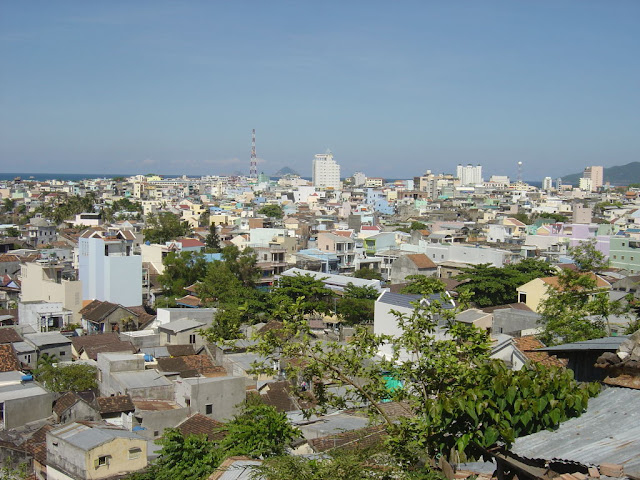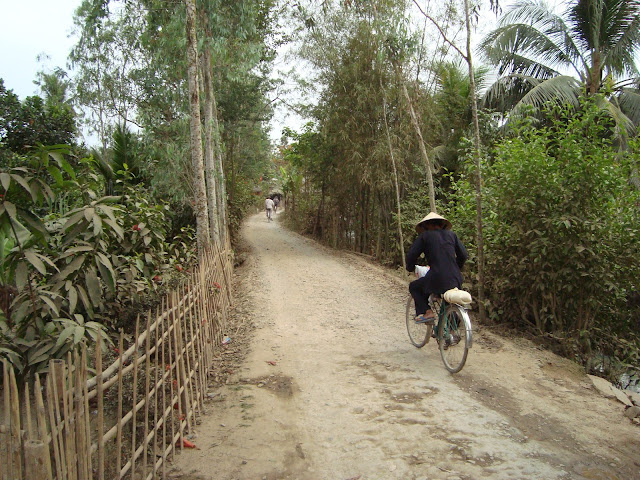 |
| Nha Trang sea port today. A tragedy occurred here in 1975. |
The port itself has an odd variety of watercraft. A freighter on the wharf has longshoremen unloading cargo, while ferry boats, and smaller tourist boats that travel to the islands are anchored nearby. With the weather declining, the tour boats sit empty and idle. The most curious here are the circular reed boats. These traditional Vietnamese fishing boats, aren't even two meters in diameter. As one fisherman paddles his small craft towards shore, this centuries old design looks out of place next to modern ships.
The wind picks up, and the skies look more ominous. I look back out towards the sea, and the view has changed. I can barely see the freighters I saw only moments before, they seem to be covered in mist. Uh oh, that’s not mist, it’s rain, and it’s coming this way. I’m about to get poured on.
This same Vietnamese port was once the scene of a tragedy, of panic and chaos of the worst kind. In April of 1975, as communists troops were advancing south, panic hit the streets of Nha Trang. The ARVN leadership had fled town, and Nha Trang would soon be overrun. Fearing the advancing North Vietnamese Army, the people of Nha Trang headed to the only escape route they had left, and that was here at the harbor.
Thousands of desperate Vietnamese were evacuated, but the small port and an insufficient number of ships could not accommodate everyone desperate to leave. The chaos to board the ships escalated into pandemonium, as fleeing ARVN troops and panicking civilians pushed towards the ships. Dozens of desperate Vietnamese died in the crush and stampede in this small port.
In the end, most of those who made it aboard the departing ships only delayed the inevitable, since they were evacuated further south. They couldn’t have known that the rest of South Vietnam would soon fall to advancing NVA troops in less than a month.
 |
| Cable cars over the port take tourists to the Vinpearl amusement park |
As rain falls upon my face, I peer across the port, and a new feature stands out. An immense cable car now runs up and over the port, all the way across to distant Hon Tre Island. At 3320m long, this is advertised as the longest cable car over water in the world. I watch as the passing cable car cabins make their nine minute ride across the water to their destination: "Vinpearl".
One of the largest amusement parks in the country, Vinpearl opened a couple years ago to great fanfare. It’s several amusement parks rolled into one, including a waterpark, an aquarium, thrill rides and animal shows. Although two miles away, the place is easy to see from the port. Giant white letters spelling ‘Vinpearl’ are built into the island’s hillside, much like the ‘Hollywood’ sign in Los Angeles. The Vietnamese love the place, although Australians I spoke to on their way back were disappointed. I think the Aussies were more accustomed to high tech theme parks from back home.
As the deluge continues, I take shelter at a drink stand, and sip green tea until the rain subsides. Then I start my hike back to the downtown. Ascending a hill, I walk past the harbor police, who are still housed in old French colonial buildings overlooking the port. The friendly officers go out of their way to get my attention and greet me, smiling and waving as I stroll past the old fence. There may be occasional foreign sailors about, but apparently not many westerners walk by.
Coming down the hill near the old emperor’s palace, I’m back in the south end of town on Tran Phu Street. This beach front road passes right by the protective wall of the former US Nha Trang Air Base, which is now a Vietnamese Air Force base. This is where my buddy Rick had his tour of duty during the war.
As I pass by, there is little activity to be seen here. It’s a very quiet air base, and I don’t see any movement at all. Maybe the Vietnamese military doesn’t have much money for jet fuel these days. I see only one bored guard sitting in a lonely guard tower. His small tower was built right atop an old American bunker, to give him a better view.
 |
| Guard tower on former US Nha Trang air base |
A benefit of being a pilot, was that he didn’t stay in the field long. He would drop off infantrymen in the field, and fly back to his secure base before dark. It made for a more comfortable war. “I was home in my bunk every night,” he said.
With other Viet Cong relaxing in Nha Trang on 'vacation', the base didn’t have a major attack the year he was there. But there were occasional shots taken at the airfield. “Once in a while Charlie would launch a mortar or a rocket at the base,” Rick recalled. “They never hit anything though.”
As I glance across the runways and the tarmac, I don’t see any more US made Hueys here, like those I saw at Tan Son Nhat Airport. The helicopters Rick flew are long gone. I recall a pub night in Saigon, when I learned where all those remaining helicopters went. That particular evening at the bar, I met Hugh, an American aviation mechanic. He was drinking with a colleague, and the pair were working for a month in Vietnam.
Hugh described his work. “We’re packing up helicopter engines,” he told me. “They get put in shipping containers, and shipped back to the US.”
“How many Huey engines have you sent back so far?” I asked.
“About 200,” he replied.
I was astonished.
 | |
| A captured US made Huey in a museum |
While working on the former US bases, Hugh told me how he had stumbled into old workshops, and found them to be time capsules from 1975. All the tools were left in the exact same spots where mechanics left them at the war’s end. Eerily, old packs of cigarettes from the ARVN were still placed exactly where they had left them, more than three decades ago.
Hugh was heading home soon, but he was planning on returning again to pack up another 100 engines. His company would later be transporting the helicopter fuselages too.
What a strange, and expensive, turn of events for American aid. The US had originally given all those helicopters to South Vietnam as military aid. Today, an American company is buying those very same helicopters back from Vietnam that America gave them for free, and is sending them all the way back to the US!





































